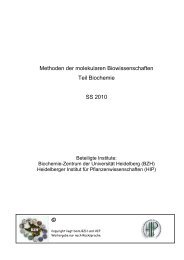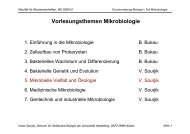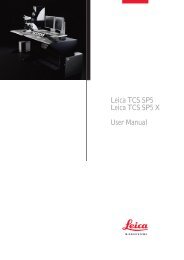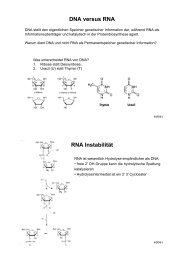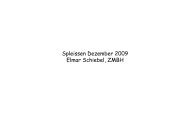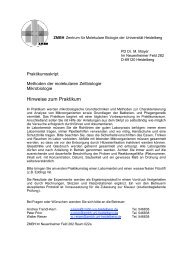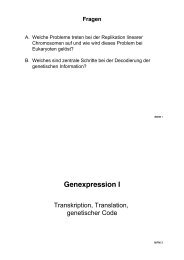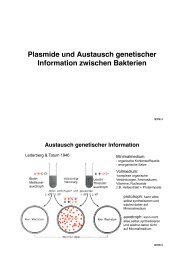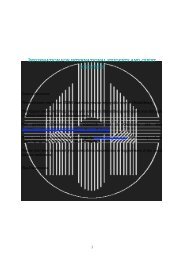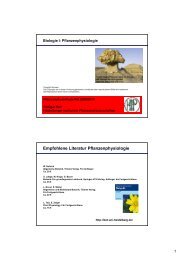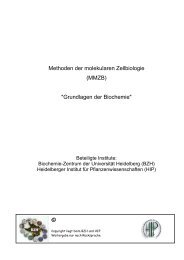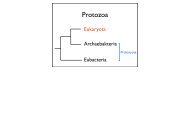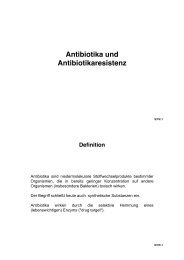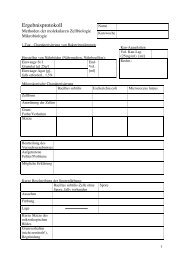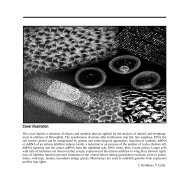ZMBH J.Bericht 2000 - Zentrum für Molekulare Biologie der ...
ZMBH J.Bericht 2000 - Zentrum für Molekulare Biologie der ...
ZMBH J.Bericht 2000 - Zentrum für Molekulare Biologie der ...
Create successful ePaper yourself
Turn your PDF publications into a flip-book with our unique Google optimized e-Paper software.
Stefan Jentsch<br />
Ubiquitin-Dependent Proteolysis<br />
The central importance of selective proteolytic systems<br />
in regulating cellular events has been recognized<br />
recently. Progression through the eukaryotic cell<br />
cycle, for example, is substantially regulated through<br />
a timed and coordinated degradation of cyclins and<br />
inhibitors of cyclin-dependent protein kinases. Similarly,<br />
the shift from one transcriptional or developmental<br />
program to another is often achieved through<br />
a timed destruction of regulatory proteins. Proteolysis<br />
is irreversible and therefore proteolytic enzymes are<br />
usually employed for controlling unidirectional cellular<br />
pathways. Selective degradation in eukaryotes is<br />
primarily mediated by the ubiquitin/proteasome pathway.<br />
Substrates of this pathway are covalently modified<br />
by conjugation to ubiquitin, a small and highly<br />
conserved protein. In most cases several ubiquitin<br />
molecules are added to the substrate as a multiubi–<br />
quitin chain in which ubiquitin molecules are arranged<br />
like beads on a string. Multiubiquitinated proteins are<br />
targeted for degradation by a large protease complex,<br />
known as the 26S proteasome. Our research focuses<br />
primarily on functional aspects of this pathway. We<br />
identify from yeast and mammalian cells the enzymatic<br />
components of this system, clone the corresponding<br />
genes, and study their functions in vitro and<br />
in vivo.<br />
A novel ubiquitination factor, E4, involved in<br />
multiubiquitin chain assembly<br />
M. Kögl, T. Hoppe, S. Schlenker, H. D. Ulrich, T. U.<br />
Mayer<br />
Proteins modified by multiubiquitin chains are the<br />
preferred substrates of the proteasome. Previous work<br />
has suggested that E1, E2, and E3 enzymes are both<br />
84<br />
required and sufficient for the formation of multi–<br />
ubiquitinated substrates. Recently, however, we could<br />
show that efficient multiubiquitination needed for proteasomal<br />
targeting of a model substrate (ubiquitin<br />
fusions) requires an additional conjugation factor,<br />
which we termed E4. This protein, previously known<br />
as UFD2 in yeast, binds to the ubiquitin moieties of<br />
preformed conjugates and catalyzes ubiquitin chain<br />
assembly in conjunction with E1, E2, and E3. Intriguingly,<br />
E4 defines a new protein family, which includes<br />
two human members and the regulatory protein NOSA<br />
from Dictyostelium required for fruiting body development.<br />
In yeast E4 activity is linked to cell survival<br />
un<strong>der</strong> stress conditions, indicating that eukaryotes utilize<br />
E4-dependent proteolysis pathways for multiple<br />
cellular functions. Interestingly, UFD2 (E4) interacts<br />
with CDC48, a member of the large family of AAAtype<br />
ATPases. CDC48 is not involved in the ubiquitinconjugation<br />
reaction but is needed for proteolysis of<br />
some substrates of the ubiquitin/proteasome pathway.<br />
Ubiquitin-like proteins from mammals and<br />
yeast<br />
D. Liakopoulos, G. Doenges<br />
Ubiquitin is one of the most highly conserved eukaryotic<br />
proteins known to date. Human ubiquitin differs<br />
from its yeast homolog by only three amino acid residues<br />
(out of 76 residues) and the proteins are functionally<br />
equivalent. In addition to ubiquitin, two classes<br />
of ubiquitin-related proteins have been identified. Proteins<br />
of the first class carry ubiquitin-like domains<br />
linked to unrelated sequences and are not conjugated<br />
to other cellular proteins. One example is the mammalian<br />
ubiquitin-related protein BAG-1 for which we<br />
showed that it functions as a regulatory cofactor of<br />
the Hsc70 chaperone. Proteins of the second class of<br />
ubiquitin-like proteins are distinguished by their property<br />
to become posttranslationally attached to other<br />
cellular proteins analogously to ubiquitin. Known<br />
members are SUMO-1 from higher eukaryotes and<br />
its yeast ortholog SMT3. Recently, we have identified<br />
a novel ubiquitin-like protein from yeast, which<br />
we termed RUB1. RUB1 displays 53% amino acid<br />
sequence identity to ubiquitin. We found that RUB1<br />
conjugation to other cellular proteins requires at least<br />
three proteins in vivo. ULA1 and UBA3 are related<br />
to the amino- and carboxyl-terminal domains of the<br />
E1 ubiquitin-activating enzyme, respectively, and together<br />
fulfill E1-like functions for RUB1 activation.<br />
RUB1 conjugation also requires UBC12, a protein<br />
related to E2 ubiquitin-conjugating enzymes, which<br />
functions analogously to E2 enzymes in RUB1-protein<br />
conjugate formation. Conjugation of RUB1 is not<br />
essential for normal cell growth and appears to be<br />
selective for a small set of substrates. Remarkably, we<br />
found that CDC53/cullin, a common subunit of the<br />
multifunctional SCF ubiquitin ligase, is a major substrate<br />
for RUB1 conjugation. This suggests that the<br />
RUB1-conjugation pathway is functionally affiliated<br />
with the ubiquitin/proteasome system and may play a<br />
regulatory role.<br />
Conjugation of the ubiquitin-like protein RUB1/<br />
NEDD8 to cullin-2 is linked to von Hippel-Lindau<br />
(VHL) tumor suppressor function<br />
D. Liakopoulos, G. Doenges; in collaboration with T.<br />
Büsgen, A. Brychzy, and A. Pause (Max Planck Institute<br />
for Biochemistry, Martinsried)<br />
Yeast RUB1 has homologs in higher eukaryotic cells.<br />
The human RUB1 homolog, NEDD8, when expressed<br />
in a yeast rub1 mutant, can complement its RUB1<br />
deficiency. Recently we found that both hCUL-1<br />
and hCUL-2 (homologs of yeast CDC53, see above)<br />
are modified by the conserved ubiquitin-like protein<br />
RUB1/NEDD8. Whereas hCUL-1 is part of a human<br />
SCF complex, hCUL-2 assembles with elongin B/C<br />
and the von Hippel-Lindau tumor suppressor protein<br />
pVHL, forming a protein complex, CBC VHL , that<br />
resembles SCF ubiquitin ligases. We could show that<br />
NEDD8-hCUL-2 conjugates are part of CBC VHL complexes<br />
in vivo. Remarkably, the formation of these<br />
conjugates is stimulated by the pVHL tumor suppressor.<br />
A tumorigenic pVHL variant, however, is<br />
essentially deficient in this activity. Thus, ligation of<br />
NEDD8 to hCUL-2 is linked to pVHL activity and<br />
may be important for pVHL tumor suppressor function.<br />
Moreover, our data indicate that modification of<br />
cullins by NEDD8 requires the existence of a preassembled<br />
ubiquitin ligase complex.<br />
External Funding<br />
During the period reported our research was supported<br />
by grants from Deutsche Forschungsgemeinschaft<br />
(project grants, SFB 352, Schwerpunktprogramm<br />
Ubiquitin/Proteasomsystem, Leibniz Program,<br />
Graduiertenkolleg), European TMR Ubiquitin<br />
Research Network, American Cancer Society, and<br />
Fonds <strong>der</strong> Chemischen Industrie.<br />
PUBLICATIONS<br />
Finley et al., (1998). Unified nomenclature for subunits<br />
of the Saccharomyces cerevisiae proteasome regulatory<br />
particle. Trends Biochem. Sci. 23, 244-245.<br />
Hauser, H.-P., Bardroff, M., Pyrowolakis, G., and<br />
85



